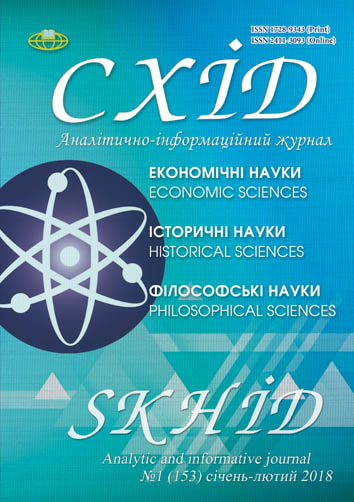The phenomenon of the carnivalization of sport in postmodern society
DOI:
https://doi.org/10.21847/1728-9343.2018.1(153).127538Keywords:
laughter, sport, carnivalization of sport, postmodern sport, social functions of laughterAbstract
This article examines the phenomenon of sport carnavalization in postmodern society, the reasons, preconditions, consequences of the postmodern transformation of sport as a social institution, turning it into a commercialized spectacle, industry, show business, entertainment practice. Traced the mutual penetration of the humorous elements in the sports and sports in karneval sfere in socio-cultural space. Thus, laughter in its various functions, manifestations, modifications is an integral part, an attribute of sport life, and an independent agent of social shifts, through which social values and ideals are established or abolished, a special festive atmosphere is created as a marker of the "boundary", the "border", "The transition" of society as a whole and sport as a social institution into a new mode of existence.
Downloads
References
Moss, M. (1996), Body Techniques, Society, Exchange, Personality, Nauka, Moscow, рр. 242-263 (rus).
Eco, U. (2007), From the game to the carnival, Full back! «Hot wars» and populism in the media, Eksmo, Moscow, p. 592 (rus).
Ponomarchuk, V. (2011), Sport as a social institution, Sports encyclopedia of life support systems, AD-Ed. Unesco, p. 324 (rus).
Ortega y Gasset, Jose (1991), About the sports-festive feeling of life, Philosophical sciences, No. 12, рр. 137-152 (rus).
Huizinga J. (2001), Homo ludens, Mysl, Moscow, p. 346 (rus).
Diem, C. (1991), Weltgeschichte des Sports, 3 rd. ed., 2 vols, Cotta, Stuttgart (ger.).
Ibragimov M. (2014), Philosophy of sport in the genesis of historical and cultural studies and in domestic perspectives, Philosophical thought, No. 1, pр. 97-110 (ukr.).
Losev A. (1994), History of Ancient Estetics, Vol. VІІІ: Results of Thousand-Than Development, Book. 2, Iskusstvo, Moscow (rus.).
Kosyak, V. (2002), Epistemology of human corporeality, ITD «Universalnaya kniga», Sumy, p. 140 (rus.).
Frayssinet P. (1968), Le Sport parmi les beaux-arts, Arts et Voyages, Paris, р. 27 (fr.).
Ivanov V. (1994), Dionysus and priodionism, Aleteyya, Saint Petersburg, p. 350 (rus.).
Moss M. (2000), Essay on the nature and function of sacrifice, Social functions of the sacred, Evraziya, Saint Petersburg, p. 448 (rus.).
Citation for: Ponomariev M. (1974), Social functions of physical culture and sports, Fizkultura I sport, Moscow, p. 310 (rus.).
Lindsay, Peter L. (1973), Attitudes towards Physical Exercise Refl ected in the Literature of Ancient Rome, History of Sport and Physical Education to 1900, ed. Earle F. Zeigler, Champaign, Stipes, Illinois, p. 179 (engl).
Nietzsche F. (1990), To the genealogy of morality. Polemic composition, 2 volum, Myisl, Moscow, p. 829, pp. 407-524 (rus.).
Elias N. (2001), About the process of civilization. Sociogenetic and psychogenetic studies, Vol. I: Changes in the Behavior of the Senior Layers in the Countries of the West, Universitetscaya kniga, Moscow; Saint Petersburg, pp. 332 (rus.).
Guttmann A. (1978), From Ritual to Record: The Nature of Modern Sports, Columbia University Press, New York, pp. 15-55 (engl).
Bourdieu P. (1993), How Can One be a Sports Fan? In: During, S. (ed.) Cultural Studies: A Reader, Routledge, London and New York, pp. 339-360 (engl).
Druzhinina E. (2012), Structural elements of the archetype (on the example of the hero and Don Quixote archetypes), Culture of the peoples of the Black Sea region, No. 231, pp. 112-116 (rus.).
YakovenkoI., Pelipenko A. (1998), Culture as a system, Yazyiki russkoy kulturyi, Moscow, p. 396 (rus.).
Burke P. (2001), Popular culture in the early modern era, UTSKD, Кyiv, p. 376 (rus.).
Alkemeyer T. (2007), Aufrecht und biegsam. Eine politische Geschichte des Korperkults, In: Bundeszentrale für politische Bildung (Hg.): Aus Politik und Zeitgeschichte, APuZ, 18, pp. 6-18. (ger.).
Sarasin P. (2001), Reizbare Maschinen, Frankfurt / M., p. 324 (ger.).
Khamitov V. (1995), Philosophy of loneliness. Experience of living in a problem. Loneliness of women and men, Naukova dumka, Kiev, p. 75 (rus.).
Canetti E. (1997), Mass and power, Ad Marginem, Moscow, p. 527 (rus.)
Saraf M. (1994), Sport in the system of culture, Golitsyno, p. 72 (rus.).
Gorbunov G. (1996), Psychology and Sport, Theory and Practice of Physical Culture, No. 12, pp. 15-18 (rus.).
Eco. U. (2009), Chatter about sports, Logos, № 6 (78), pp. 188-193 (rus.).
Hasanova Z. (1998), Women in initially male sports, Theory and practice of physical culture, № 2, pp. 56-58 (rus.).
Kanatiev K. (2015), Influence of gender characteristics of athletes on the psychological climate of communication in a sports team, Modern problems of science and education, № 4, available at: http//www/science-education.ru/article/view?d=20644 (rus.).
Il’in, E. (2002), Differential psychophysiology of men and women, Piter, Saint Petersburg, p. 544 (rus.).
Averintsev S. (1992), Bakhtin, Laughter, Christian, M. M. Bakhtin as a Philosopher, Nauka, Moscow, pp. 7-19 (rus.).
Edensor T. (2012), National Identity. Popular Culture and Everyday Life, New York; Oxford, England: Berg (engl).
Gaddafi M. (2012), Testament, Algorithm, Moscow, p. 338 (rus.).
Kozintsev A. (2007), Man and laughter, Aleteyya, Saint Petersburg, p. 236 (rus.).
Downloads
Published
How to Cite
Issue
Section
License
Copyright (c) 2018 Olha Maltseva

This work is licensed under a Creative Commons Attribution-NonCommercial-NoDerivatives 4.0 International License.
1. Authors bear responsibility for the accuracy of facts, quotations, numbers and names used.
2. Manuscripts are not sent back.
3. The publisher does not always agree with the authors' opinion.
4. The authors reserve the right to authorship of the work and pass the first publication right of this work to the journal under the terms of a Creative Commons Attribution-NonCommercial-NoDerivatives 4.0 International License. This license allows others to distribute (copy) the published work for non-commercial purposes, provided there is mandatory attribution to its authors and a link to the first publication in our journal.
5. The authors have the right to conclude separate supplement agreements that relate to non-exclusive work distribution in the form in which it has been published by the journal (for example, to upload the work to the online storage of the journal or publish it as part of a monograph), provided that the reference to the first publication of the work in this journal is included.

